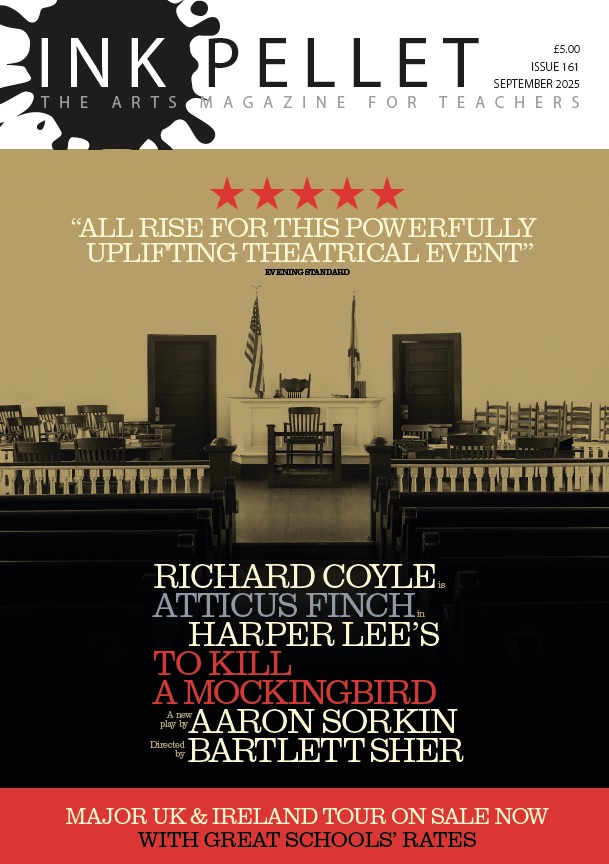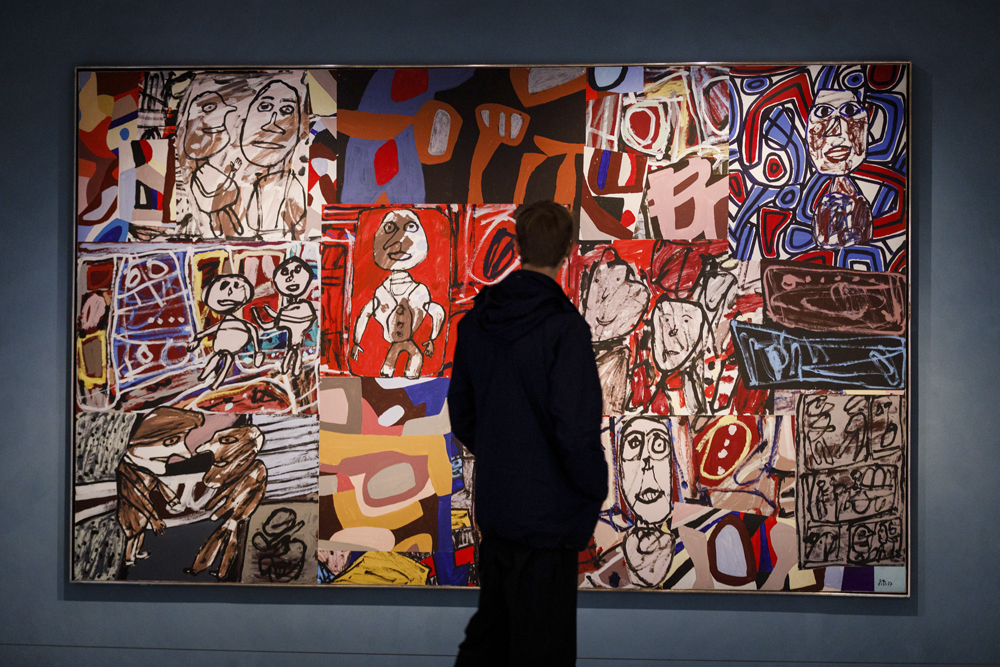There are two things I am particularly looking for or concerned with when I visit an art gallery when reviewing a show for this publication. The first centres on how the work on display can provide stimulus for students (from primary right up through secondary to sixth-form students), the level of engagement that could be expected or hoped for. Given an average day, and average group of students, will they end the day feeling inspired, captivated, enchanted even?
The second comes from approaching the exhibition from the point of view of the teacher. Will it provide enough material for a sustained and productive series of classroom-based activities that will be successful? But I am also mindful of other, less-formal requirements; will my colleagues (again on what might be a long, complicated, very wet or rather hot day) feel as though all that effort and time has been worthwhile? It’s good when the staff leave with a sense that their creative batteries have been recharged as it’s so easy to wear them out over weeks and months without any external input to boost them. The Barbican’s latest offering, “Dubuffet: Brutal Beauty” fulfills both these objectives pretty well.
It’s especially important right now, as we all start, however tentatively, to emerge out of forced hibernation, to meet these two aims.
Travelling by train from the south-west to the City, as I approach it, makes for a slightly awkward journey to the Barbican. Waterloo to Moorgate on the tube involves negotiating some more troublesome tube stations; we teachers try to avoid any changes that take time and can make for lost students. Then there’s the walk to the gallery itself, which isn’t the most straightforward, nor the most picturesque compared to, say, walking the south bank to Tate Modern. But the building itself is always surprising and powerful, and I forget the impact for a teenager can be even more. In my experience young people very often much prefer its concrete structures to the more flamboyant or decorative spaces of the Victoria and Albert Museum, for instance. It’s worth taking time before making the trek to Barbican to prepare them for it, not to spoil the first impressions, but to build it up. I discuss the curious history of the place, the original philosophy behind the scheme (high quality culture and housing, together, for the masses). I explain the details: brass handrails, the wide stairwells and walkways. On arrival a good coffee bar provides an opportunity to rest after the journey and for students to fully explore. I encourage them to take in the pitted surfaces of the interior and exterior walls. How many different types can they find, that those Italian stonemasons painstakingly made by hand? Initial photographs or drawings of the inside and outside, all line and shape, blocks of grey tones, are well worth the time to notice, and this is all before we’ve even entered the gallery space.
Dubuffet once said, “Art should always make you laugh a little and fear a little. Anything but bore”. That’s a great statement to make. We could print that off and put it on our classroom walls, couldn’t we? Laugh, yes please. Fear, well, yes, maybe. The big artists’ quotes that litter the pale blue walls of the exhibition aren’t intrusive, and might even be too hidden, it’s a difficult balance to strike, but again is something that our students could be asked to seek out and note down. Do they agree with them? All of them? Always? To what extent? Even the colour background can provide a conversation starter. It’s an unusual choice. Does it add or detract? What might work better? Why might these curatorial decisions have been made, we can productively wonder together.
If he is known for anything, Dubuffet was associated with the Art Brut movement (literally ‘raw art’) that rejected conventional notions of art and beauty, form and material. He sought out the visual poetry of everyday life. For him the surface of a pavement had as much importance and necessity as the human form. As a result, his paintings (and sculptures, theatrical props and murals) have a wildness to them. They feel free and extremely energetic. That’s a liberating sensation for anyone to experience. This retrospective, the first in the UK since the mid sixties, is welcome not least because his work has fallen somewhat into obscurity, but yet has so much to offer, for its wide scope of subject and high level of invention.
Dubuffet worked right across the full range of genre, and this show includes early lithographic prints that illustrated poems, portraits of the Paris social circle from the late 1940s, right through to his extravagant large scale theatrical performances of the early 1970s, for which he designed the abstract costumes, devised the choreography and produced the music, when he was in his seventies. That’s an impressive working life, and an unusual span of activity.
He was lucky in that taking on his father’s successful wine business meant he could devote himself entirely to his work. He is unusual for the extent of his materials and tools. This show includes work made with glass, coal dust, pebbles, string, sponge, lava stone and even butterfly wings (not that I’d necessarily encourage my classes to use all of those). Knowing that meaningful and effective imagery can be produced with the humblest or strangest of ingredients I think is of real benefit. Most art room store cupboards will have A1 white cartridge paper (with any luck) and charcoal probably, paint brushes hopefully, but Dubuffet reminds us that we can think more broadly, more imaginatively, when gathering supplies. Suitable resources are everywhere if only we re-think how to look and find them.
Similarly, this show has taught me that paintings, displayed on a wall, need only be part of what can be made. We can illustrate poems, we can work over newspaper front sheets, adding our own provocative alternative headlines in secret code, we can construct on scales from the very small to the epic. Dubuffet re-appropriated war-time resistance messages (“The key is under the shutter”) that create instant intrigue. What fun to think up our own.
I was especially struck by his pictures, produced entirely from memory, of friends and acquaintances, made by carefully scrutinizing his models after hours of just looking. The results, in sand and ash, are distorted, intense, head and shoulder portraits.
In terms of landscape, rather than depict real or external spaces, specific or idealized, he chose instead to show us the ‘internal landscape’ of the mind. Having lived in Algeria after the war, learnt Arabic and travelled with Bedouin tribes, his abstract canvases capture the expansive extremities of those most unforgiving of environments. With the horizon lines being elevated in the compositions as they are, there’s the sense that we are looking underground, yet the surfaces are so textured as to appear lunar in form.
His collages (or ‘assemblages’ as he preferred to call them) evolved on a holiday with friends who were gathering butterflies and gluing their wings onto paper. It’s not an activity that would be deemed suitable today perhaps (though Damien Hirst has employed similar techniques), but it has made for a strangely unique effect. The wings shine with a rainbow luster that probably wouldn’t be achievable by any other means.
Some of the most abstract works on show are made from quick drying enamel (after seeing the work of the Abstract Expressionists in New York in the fifties). He would shake a tree branch loaded with paint over fresh plaster, to “soften the colour”. The “delicate speckles” appear as though they could be microscopic depictions of the earth or scientific observations of deep space. Again and again I was reminded of the Barbican’s walls, though no such connection was formally made, a missed opportunity which surprised me.
His more figurative paintings, Paris street scenes after he returned to live there after a break of some time, are in many ways more traditional (we see shop fronts, buses and restaurants) although his use of distorted perspective, at once flattened and skewed, make for odd views. It’s as if we’re drunk or staggering; disorientated people lean or slide at odd angles.
One series of work (and each of the Barbican’s exhibitions fifteen spaces are devoted to one) brings together his “L’Hourloupe” (a portmanteau of words that mean to play a trick, hoot, roar and the name for a male wolf). They are animalistic creatures, made with a four-colour ballpoint pen. He would doodle freely, cut out and layer these drawings, embellishing with red and white stripes. The same feel is deployed in his freestanding, large-scale theatre costumes and show the signature ‘Dubuffet style’. He would explore alternative compositions using magnetic panels that he could freely rearrange until he was satisfied. The show concludes with more, wall-sized abstract, cross-hatched paintings. These dense, layered works inspired a generation of younger artists. Which is what we are all trying to do.
Barbican Art Gallery, London, UK
17 May – 22 August 2021
www.barbican.org.uk/whats-on/2021/event/jean-dubuffet-brutal-beauty



